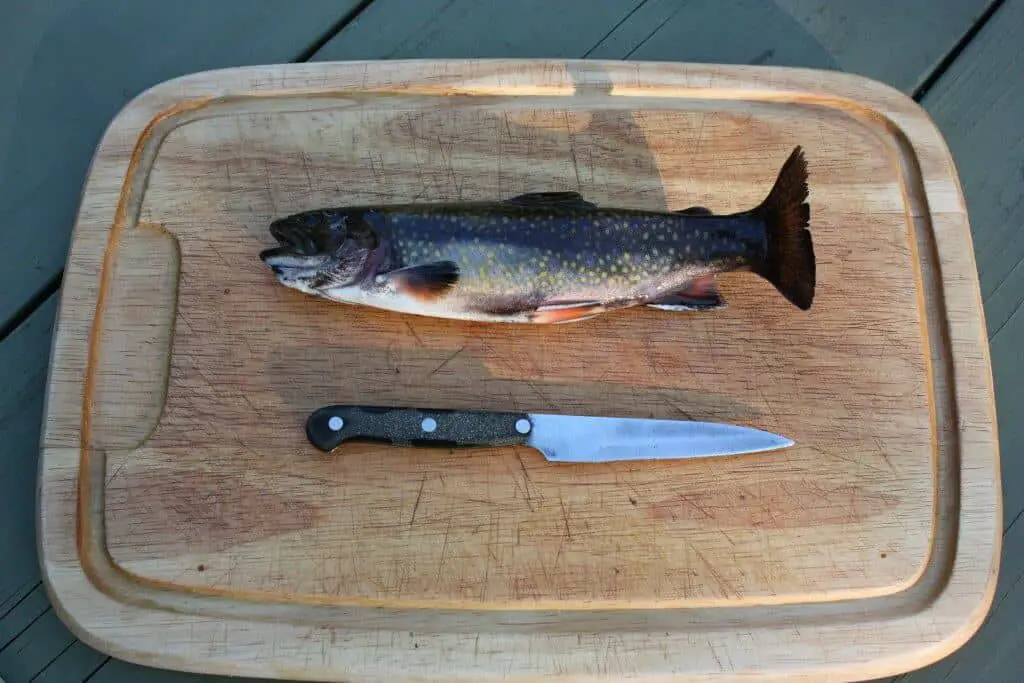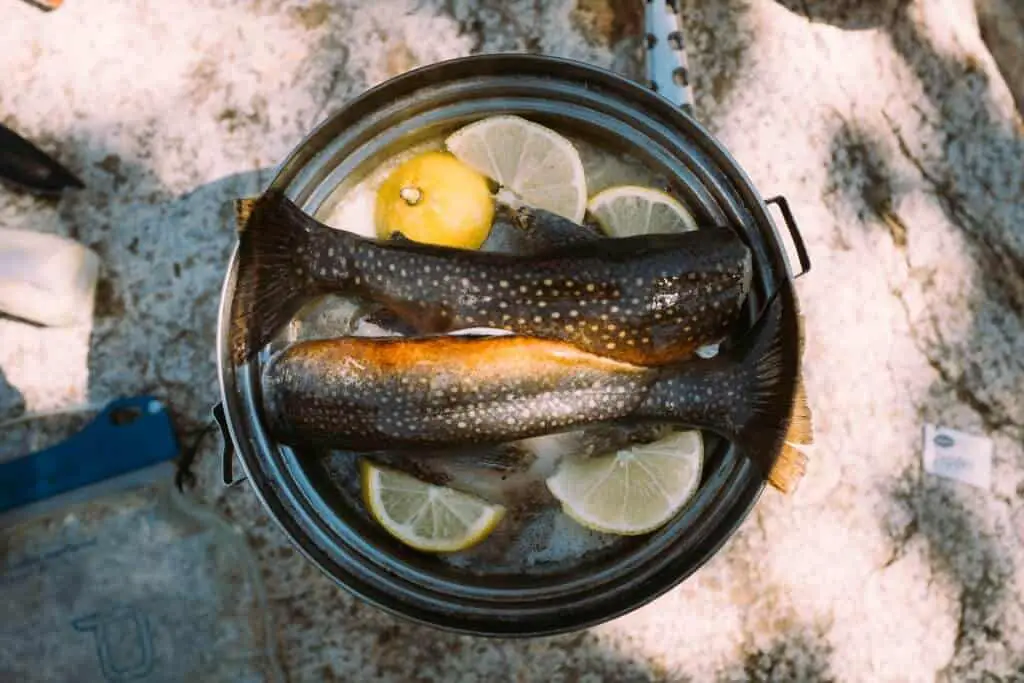As a recreational angler it is exciting to reel a large fish. But what happens once you bring the fish back home? It is important to know how to clean a fish so that it can be prepped for cooking. Eating a freshly caught fish is always a delight regardless of whether you are planning to cook a whole fish or you are making a steak.
If you are cooking a whole fish then you need to prep the fish by removing the scales, trimming the fins, and removing its guts. However, if you planning to fillet the fish then it involves more work. Let’s take a look at the things you need to clean a fish.
Preparations for Cleaning a Fish: Things You Will Need
As cleaning a fish is a messy task it is good to have everything ready. Here is a list of items that would come in handy while cleaning your catch:
A sharp fillet knife.
A cutting board that is ideally double the length of the fish as it will make your job easy.
A bowl of water if you are cleaning the fish outside the house.
Platter for keeping the clean fish.
A reuseable container to dispose the guts, roe and other organs of the fish.

How to Clean a Fish
First, consider if you want to weigh the fish. Many anglers prefer to just clean and cook the entire fish without cutting it into fillets. Cooking a whole fish is good only if the fish has smaller scales. For instance, fish such as trout and sardines can be cooked as a whole.
Also, the fish should be cleaned soon after catching it as fresh fish have the best flavor. Care should be taken while cleaning the fish as they are slippery and you might end up hurting yourself with the knife.
Here are the steps on how to clean a fish that will make the task super easy:
- Rinse the fish thoroughly to remove the slime and place the fish on the cutting board. The tip of the knife should be put in the anal orifice of the fish and one should move the knife from the belly toward the head. Hold the fish with the help of a towel so that you can get a good grip on it.
- Make a sharp incision at the throat to detach the gills from the head.
- Spread the fish open at the cut and scrape out the intestines and other organs and discard them.
- Make a cut at the anal area of the fish and discard this portion as well.
- Also, if desired, you can cut the head of the fish and remove the pectoral fin.
- Wash the inner cavity of the fish with water and ensure that there is no black tissue left so that the fish does not have an unpleasant taste after cooking.
How to Descale a Fish
Fish such as bass and sunfish or even koi have comparatively larger scales and so they need scaling. Scaling a fish requires removing the scales from the outer surface of the fish with the help of a spoon or a scaler. Follow these steps to descale a fish:
- Place the fish on the cutting board with its back facing you and hold it firmly with one hand.
- Start scraping the knife from the tail to the head and remove the scales in a stroking motion. You will notice that the scales will scrape off easily once you move your knife back and forth.
- Remember that you need to make a small and gradual movement toward the head. Start by cleaning the fins of the fish and then move to the belly and the back.
How to Fillet a Fish
Large fish such a salmon and steelhead should be filleted before you cook them. A fillet refers to the meaty portion of the fish that is removed from the side and is cut parallel to the spine. It takes more effort to fillet a fish but it will ensure that you don’t have to deal with the bones while eating.
Once you get used to filleting you can easily fillet a pile of fish without making a lot of effort. However, as a beginner you need not worry if you are not able to scrape of all the meat as you will learn to do it eventually. Follow these basic steps that will come in handy as you fillet a fish:
- Lay the fish on the side and put it on the cutting board. Make a cut behind the gill cover and the pectoral fin down to its backbone. Ensure that the filleting knife is sharp and flexible. You could consider using an electric fillet knife as well.
- Do not remove the knife and now cut through the ribs and move toward the tail. Now turn the fish around and cut the fillet away from its backbone.
- Turn the fish again and repeat the process on the other side.
- Move the knife from side to side and angle it toward the skin so that you are able to separate the meat from the skin.
How to Gut a Fish
You need to remove the gut of the fish prior to cooking as it is inedible. Consider composting the scraps to use them as fertilizer later, if you have a garden! Put on a pair of gloves before gutting to protect your hands as it can be a messy endeavor. Follow these simple steps to gut a fish effectively:
- Rub the fish on both sides with the back of the knife to remove its scales.
- Keep the tip of the knife in the anal orifice of the fish and move the knife from the belly toward the head.
- Remove the guts and gills by pulling them out. This is where having a glove helps in protecting your hands.
- Clean the insides with running water until the water becomes clear.
- Dry the fish with the help of a paper towel and cut the fins with a knife.

How to Clean a Fish: Tips & Warnings
Fish needs to be handled carefully and it is best to clean the fish right after you bring the catch home as they rot easily. Here are a few do’s and don’ts that will help you get the best out of your catch:
- As fish is highly perishable, do put the dead fish in an ice cooler and cover it with ice for proper cooling.
- The back of the fish is very slimy so do insert your thumb into the gill area while scaling. This will help in maintaining the grip and will avoid any possible injury.
- Do keep a plastic bag or better a reuseable container before you start cleaning the fish so that you can dispose the guts and organs.
- While cleaning the fish make sure that you do not make a deep incision as it can puncture the guts and organs. This might lead to bacterial infection.
- Be careful while removing the fins of the fish as they are sharp and you might end up cutting yourself.
- Some fish have a dark inner membrane that is oily and gives it a strong flavor and odor. Do not forget to remove this dark membrane so that it doesn’t affect the taste.
Follow these tips to ensure hassle free cleaning and gear up to have a delicious meal.
Frequently Asked Questions (FAQ)
How long should/can you wait before cleaning your fish?
It is good to clean the fish immediately after you bring the catch home. However, you can keep an ungutted fish on ice for two days before cooking.
What can I do with some of the “waste”?
You can use the waste as a fertilizer. This fertilizer is good for both indoor and outdoor plants as the microbes in the soil feed on it and make the soil rich in organic content.
How can you remove the smell from the fish?
If the fish has just started smelling it is good to rinse it in cold water as it helps in removing the bacteria that cause the odor. After rinsing the fish, you can dry it with a paper towel so that it is ready for cooking.
Can you freeze a fish without gutting?
It is not a good practice to freeze a fish without removing the guts. Always clean the fish before you plan to freeze it.
How to freeze a fish?
Once the fish is cleaned and gutted, you can keep it in a zip lock bag. Ensure that you remove all the air from the bag. You can also follow the ice glazing method for freezing the fish.

Happy Fish Cleaning
As a recreational angler it is good to know how to clean a fish. The tips and tricks given here are beneficial for most of the fish you catch. But if you end up catching a unique variety then look up for specific tips on cleaning a particular fish.
So, what are you waiting for? Get ready to prep the fish for an awesome meal, whether that means cooking them or maybe throwing them on a grill!